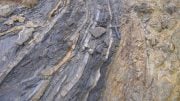
The Permian-Triassic mass extinction, also known as the Great Dying, was the largest mass extinction in Earth’s history. It occurred about 252 million years ago and wiped out about 90% of marine species and 70% of terrestrial species.
The Latest Permian Mass Extinction (LPME) was the largest extinction event in Earth’s history to date, resulting in the loss of between 80-90% of life on the planet. Despite extensive research, the exact cause of the dramatic changes in climate during this time remains unknown.
A team of international scientists, including Tracy Frank, the Professor and Department Head of the UConn Department of Earth Sciences, and Professor Christopher Fielding, are collaborating to uncover the cause and events of the Latest Permian Mass Extinction (LPME) by studying the mercury deposits found in sediments in Australia and South Africa, which originated from Siberian volcanoes. Their research has recently been published in the journal Nature Communications.
Though the LPME happened over 250 million years ago, there are similarities to the major climate changes happening today, explains Frank:
“It’s relevant to understanding what might happen on earth in the future. The main cause of climate change is related to a massive injection of carbon dioxide into the atmosphere around the time of the extinction, which led to rapid warming.”
In the case of the LPME, it is widely accepted that the rapid warming associated with the event is linked to massive volcanism occurring at a huge deposit of lava called the Siberian Traps Large Igneous Province (STLIP), says Frank, but direct evidence was still lacking.
Volcanos leave helpful clues in the geological record. With the outpouring of lava, there was also a huge quantity of gases released, such as CO2 and methane, along with particulates and heavy metals that were launched into the atmosphere and deposited around the globe.
“However, it’s hard to directly link something like that to the extinction event,” says Frank. “As geologists, we’re looking for a signature of some kind — a smoking gun — so that we can absolutely point to the cause.”
In this case, the smoking gun the researchers focused on was mercury, one of the heavy metals associated with volcanic eruptions. The trick is finding areas where that record still exists.
Frank explains there is a continuous record of the earth’s history contained in sediments in marine environments which acts almost like a tape recorder because deposits are quickly buried and protected. These sediments yield an abundance of data about the extinction and how it unfolded in the oceans. On land, it is more difficult to find such well-preserved records from this time period.
To illustrate this, Frank uses Connecticut as an example: the state is rich with 400-500-million-year-old metamorphic rocks at or near the surface, with a covering of glacial deposits dating to around 23,000 years ago.
“There’s a big gap in the record here. You have to be lucky to preserve terrestrial records and that’s why they aren’t as well studied, because there are fewer of them out there,” says Frank.
Not all terrains around the world have such massive gaps in the geologic record, and previous studies of the LPME have focused primarily on sites found in the northern hemisphere. However, the Sydney Basin in Eastern Australia and the Karoo Basin in South Africa are two areas in the southern hemisphere that happen to have an excellent record of the event, and are areas Frank and Fielding have studied previously. A colleague and co-author, Jun Shen from the State Key Laboratory of Geological Processes and Mineral Resources at the China University of Geosciences, reached out and connected with Frank, Fielding, and other co-authors for samples, with hopes to analyze them for mercury isotopes.
Shen was able to analyze the mercury isotopes in the samples and tie all the data together says Frank.
“It turns out that volcanic emissions of mercury have a very specific isotopic composition of the mercury that accumulated at the extinction horizon. Knowing the age of these deposits, we can more definitively tie the timing of the extinction to this massive eruption in Siberia. What is different about this paper is we looked not only at mercury, but the isotopic composition of the mercury from samples in the high southern latitudes, both for the first time.”
This definitive timing is something that scientists have been working on refining, but as Fielding points out, the more that we learn, the more complicated it gets.
“As a starting point, geologists have pinpointed the timing of the major extinction event at 251.9 million years with a high degree of precision from radiogenic isotope dating methods. Researchers know that is when the major extinction event happened in the marine environment and it was just assumed that the terrestrial extinction event happened at the same time.”
In Frank and Fielding’s previous research, they found that the extinction event on land happened 200-600,000 years earlier, however.
“That suggests that the event itself wasn’t just one big whammy that happened instantaneously. It wasn’t just one very bad day on Earth, so to speak, it took some time to build and this feeds in well into the new results because it suggests the volcanism was the root cause,” says Fielding. “That’s just the first impact of the biotic crisis that happened on land, and it happened early. It took time to be transmitted into the oceans. The event 251.9 million years ago was the major tipping point in environmental conditions in the ocean that had deteriorated over some time.”
Retracing the events relies on knowledge from many different geologists all specializing in different methods, from sedimentology, geochemistry, paleontology, and geochronology, says Frank,
“This type of work requires a lot of collaboration. It all started with fieldwork when a group of us went down to Australia, where we studied the stratigraphic sections that preserved the time interval in question. The main point is that we now have a chemical signature in the form of mercury isotope signatures, that definitively ties the extinction horizon in these terrestrial sections that provide a record of what was happening on land due to Siberian Traps volcanism.”
Reference: “Mercury evidence from southern Pangea terrestrial sections for end-Permian global volcanic effects” by Jun Shen, Jiubin Chen, Jianxin Yu, Thomas J. Algeo, Roger M. H. Smith, Jennifer Botha, Tracy D. Frank, Christopher R. Fielding, Peter D. Ward and Tamsin A. Mather, 3 January 2023, Nature Communications.
DOI: 10.1038/s41467-022-35272-8









Apples to oranges. He has NO IDEA if the CO2 was causational or mearly an effect of the eruption. He also does not know if CO2 caused the drying.
Yes, the claim that “The main cause of climate change is related to a massive injection of carbon dioxide into the atmosphere around the time of the extinction, which led to rapid warming.” is not without controversy. There is very strong evidence from Antarctic ice cores that warming preceded the rise in CO2 during the end-Pleistocene. It makes sense because CO2 is less soluble in warm water than in cold water, leading to out-gassing. Also, bacterial decomposition of organic detritus accelerates as temperatures increase.
Other researchers have found evidence that magmatic sills were injected into coal beds, releasing not only CO2, but also toxic carbon monoxide, sulfur oxides, and aromatic hydrocarbons. It is well known that coal concentrates mercury, which is released when heated. It is likely that the toxic gases killed off higher forms of life, starting on land first, and then the dead bodies provided food for bacteria, which released CO2 and methane. Sulfur trioxide, when combined with water, creates sulfuric acid, which is a strong acid (unlike carbonic acid) that is poorly buffered and very effective at lowering pH. I wonder why the authors neglected to say anything about the coal beds?
It seems counter-intuitive to believe CO2 caused drying when in the last 20 years it has greened an area the size of America.